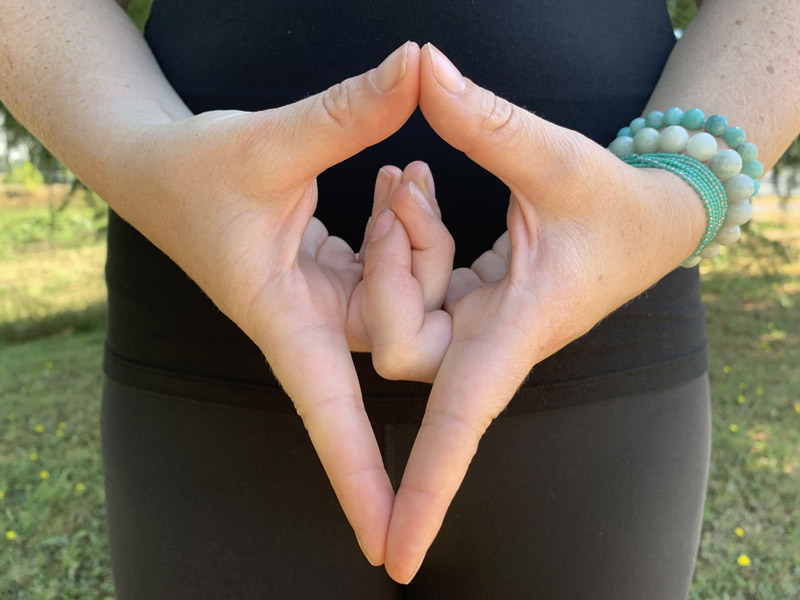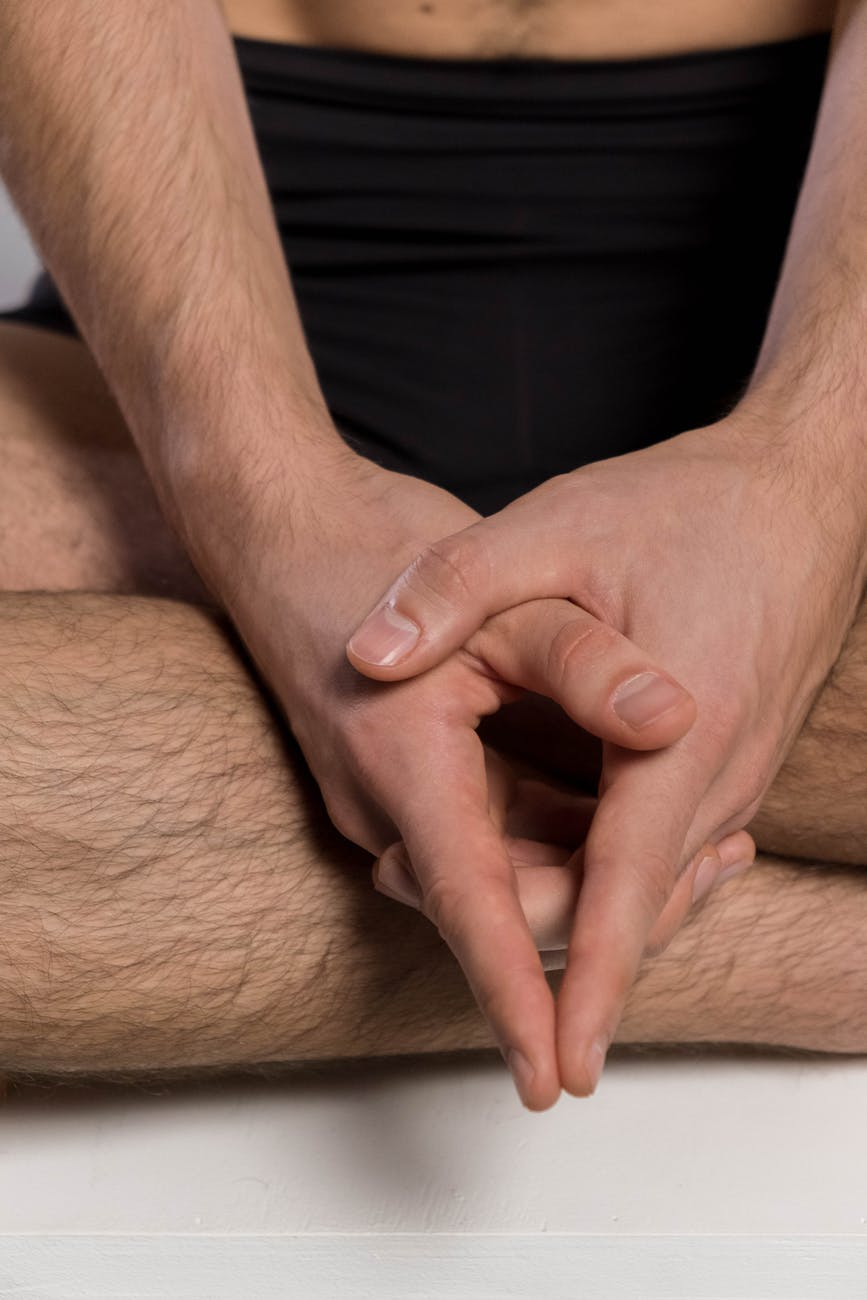Yoni Mudra Meaning: The word Yoni stands for ‘womb’ or the ‘source.’ Yoni mudra is a mudra that invokes the primary energy or shakti inherently present in the source of creation or the womb.
What is a mudra?
Mudra is a Sanskrit word that means “seal”, “mark” or a “gesture.”
It can be considered as subtle physical movements that affect the mood, perception, awareness, and concentration levels of a person.
Mudra may involve the whole body, where practices of asana, pranayama, bandha and visualization techniques are combined to make one mudra. Or, a mudra can just be a simple hand gesture.
In Kularnava Tantra, mudras are also defined as a ‘seal’, ‘short-cut’, or ‘circuit by-pass. [2]
Mudras serve as a direct link between the annamaya kosha (the physical body); manomaya kosha (the mental body); and pranamaya kosha(the pranic body).
Mudras are used to balance the flow of prana in the body. Redirect subtle energy to the upper chakras to induce higher states of consciousness.
Mudras can lead to the awakening of the pranas, chakras and kundalini. When perfected and practiced for a long time, they alone can bestow major siddhis and psychic powers to a practitioner.
Mention of Yoni Mudra in Scripture

Translation
“The great Yonimudra is to be kept secret. It is hard to obtain even for the gods. As soon as he masters it the yogi is sure to enter samadhi.” [1]

Translation
“By means of Shambhavi, Bhramari, Khechari, and Yonimudra, four types of samadhi arise: dhyana, nada, rasananda, and laya siddhi.” [1]

Translation
“By performing Yonimudra, the yogi can himself become one with Shakti. In the bliss of sexual love, he can sport in the supreme self.”[1]

Source: Ambuja Yoga
Yoni Mudra Technique
- Take a comfortable meditation posture such that your head and spine is straight.
- Place the palms of your hands together with the fingers and thumbs straight and pointing away from the body.
- Place the pads of your index fingers together and the turn your little, ring and middle fingers inwards such that the back of these fingers are touching.
- Then interlock your little, ring and middle finger.
- Stretch the thumb towards the body and join the pads of the fingers together to form the base of a yoni or womb shape.
- The elbows might naturally turn to the sides while performing this mudra. That is good as it helps to open up the chest area.

Photo by cottonbro on Pexels.com
Yoni Mudra Technique Variation
- Yoni mudra can also be performed by just interlocking the little, ring and middle fingers without turning them inwards.
- The thumbs can be outstretched (with their pads touching) towards the body or the thumbs can be crossed in front of the out-stretched index fingers.
Duration/How Long?
Beginners can practice this mudra for 15 to 20 minutes. As you gain experience you can stretch it to 30 minutes. Like most yogic/meditative practices a light stomach is preferred before commencing the practice.
Yoni Mudra Benefits
- Yoni mudra links energies from the right hand into the left hand and vice versa. This helps in balancing the energies of the body.
- It helps to balance the activities of the right and the left hemispheres of the brain.
- It intensifies the flow of prana (vital energy) in the body.
- It helps in maintaining pranic balance between the koshas.
- It prevents from prana being dispersed out of the body.
- This mudra helps to make the mind and the body calm and stable during meditation.
- Increases concentration and awareness.
Yoni Mudra Side Effects
- According to yogic tradition and in established ashrams, mudras are usually introduced later, i.e., when proficiency has been attained in asana, pranayama and bandha. This is because first the gross body blockages are removed, and then through mudras the subtle blockages are targeted.
- Always begin any Yoga practice for the minimum duration.
- Always listen to your body and be aware of how it is responding to a practice. If it starts troubling you then stop the practice.
FAQS
- What is the yoni mudra used for?
Yoni mudra is a symbolic gesture or seal that is used in yoga to cultivate inner focus, stillness, and a deeper awareness of the body and mind. It is often practiced as a part of hatha yoga and meditation to help connect with the root or base of the body, which includes the pelvic area, the organs of reproduction, and the perineum.
- When should I practice yoni mudra?
It can be practiced at any time, but it is often recommended to practice it during meditation or pranayama (breathing) exercises. It is also helpful to practice it when you are feeling stressed, anxious, or disconnected from your body.
- How do you do yoni mudra?
To practice this mudra, interlace your fingers and then bring your hands to your pelvic area. The fingers of your right hand should rest on top of the fingers of your left hand, with the thumbs touching at the base of the pelvis. You can then rest your hands in your lap or on your thighs while holding the mudra. The detailed technique is written above.
- How long do you hold the yoni mudra?
The length of time that you hold the yoni mudra may vary depending on your comfort level and experience. It is typically held for 15 mins minutes, and you can gradually increase the length of time as you become more comfortable with the practice. While holding the mudra, it is recommended to focus on your breath and allow your awareness to rest in the pelvic area.
- What are the potential side effects of practicing yoni mudra?
Yoni mudra is generally considered safe and does not have any known harmful side effects. However, it is important to practice it correctly and with proper guidance to avoid any discomfort or injury. The detailed list of side-effects is given above.
- What is the recommended posture for practicing yoni mudra?
It is typically practiced while seated in a comfortable cross-legged position or in a chair. The back should be straight, and the hands should be placed on the pelvic area.
- How can yoni mudra be beneficial for periods?
This mudra is believed to help relieve menstrual cramps and promote hormonal balance in women. It can also help to reduce stress and anxiety, which can contribute to menstrual irregularities.
- What is the significance of using yoni mudra in puja?
Yoni mudra is a symbolic gesture that represents the divine feminine energy in Hinduism. It is often used in puja (worship) ceremonies as a way to honor and connect with this energy.
- Where can I find a downloadable PDF guide for practicing yoni mudra?
There are various online resources where you can find downloadable PDF guides for practicing yoni mudra. These may include yoga and meditation websites, as well as online marketplaces that sell digital products. Or you can contact us and we will send you a detailed pdf on how to practice this mudra.
- Is yoni mudra only for women, or can men practice it as well?
While this mudra is commonly associated with women, men can also practice it as a way to connect with the root or base of the body and cultivate inner awareness.
- Can yoni mudra be helpful for increasing fertility?
Yoni mudra is believed to help balance the hormonal system and promote overall well-being, which may have a positive impact on fertility. However, it is important to consult with a healthcare professional if you are experiencing fertility issues.
References
- Book: The Gheranda Samhita: The Original Sanskrit and an English Translation, edited by James Malinson
- Book: Yoga Darshan: Vision of the Yoga Upanishads by Swami Niranjanananda Saraswati
- Book: Asana Pranayama Mudra Bandha by Swami Satyananda Saraswati

2 thoughts on “Yoni Mudra (source of power): Technique, Benefits, Side-Effects”